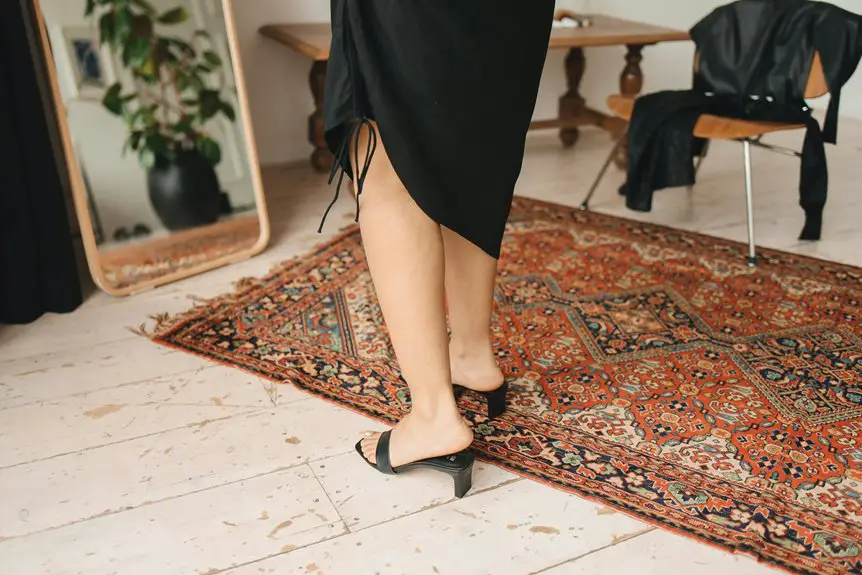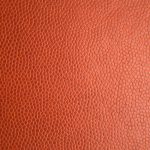A bouclé carpet features tightly looped yarns that create a textured, durable surface, perfect for hiding dirt and wear. If you want a long-lasting, stylish floor covering that adds warmth and softness to living rooms or bedrooms, it’s a smart option. Keep in mind, loops may snag under heavy traffic or sharp objects, so regular care is needed. If you’re curious about how this carpet fits your space and care needs, exploring its benefits and challenges will help you decide.
Table of Contents
Key Takeaways
- Bouclé carpet features looped yarns creating a textured, durable surface ideal for hiding dirt and footprints.
- Made from wool or synthetic fibers, bouclé offers a balance of softness, resilience, and budget-friendly options.
- It provides warmth, sound insulation, and a unique visual appeal suitable for living rooms, bedrooms, and offices.
- Bouclé carpets resist crushing but require gentle maintenance to prevent snagging and preserve loop texture.
- Avoid placing bouclé in high-traffic or moisture-prone areas, and clean spills promptly to maintain appearance.
Understanding the Bouclé Carpet Texture
Bouclé carpet features a unique looped texture that gives your floors a distinct, tactile feel. When you run your hand across it, you’ll notice the tight, curly loops that create a bumpy yet soft surface.
This texture doesn’t just look interesting; it also helps hide dirt and footprints better than smooth carpets, making it practical for busy areas. The loops can vary in size, giving you options from subtle patterns to bolder, more dramatic effects.
Because of its construction, bouclé carpet tends to be durable and resistant to crushing, so it holds up well over time. Choosing bouclé means you’re adding both style and functionality to your space with a carpet that stands out in texture and performance.
History and Origins of Bouclé Carpets
You mightn’t realize it, but bouclé carpets have roots in early textile techniques that focused on creating looped textures.
Over time, these methods evolved, shaping how bouclé carpets are crafted today.
Understanding this history can help you appreciate the unique style and durability of bouclé in your home.
Early Textile Techniques
Although textile methods have evolved over centuries, the looped yarn technique at the heart of bouclé carpets dates back to early fabric crafting traditions.
When you explore ancient textiles, you’ll find that early weavers used loops to add texture and durability to fabrics. This method wasn’t just decorative; it helped create strong, flexible materials suited for everyday use.
By looping yarns, artisans achieved a unique surface that resisted wear, a quality you still appreciate in bouclé carpets today. Understanding these early techniques gives you insight into why bouclé remains popular—its roots lie in practical, hands-on craftsmanship that prioritized function and style.
Evolution in Carpet Making
The looped yarn technique that shaped early textiles naturally found its way into carpet making, influencing how we create and appreciate floor coverings today. Bouclé carpets evolved from this method, gaining popularity for their textured, durable loops. As technology advanced, manufacturers refined loop size and yarn twist, enhancing both aesthetics and resilience. You’ll find bouclé carpets blend traditional craftsmanship with modern innovation, making them a timeless choice.
| Era | Key Development |
|---|---|
| Early 1900s | Hand-tufted looped carpets |
| Mid 1900s | Introduction of synthetic fibers |
| Late 1900s | Machine-made bouclé carpets |
| 2000s+ | Eco-friendly and durable blends |
This evolution means you get style and function in one carpet.
Materials Used in Bouclé Carpets
Bouclé carpets owe their distinctive texture to the unique fibers and yarns used in their construction. You’ll find bouclé made from various materials like wool, nylon, polyester, and sometimes blends.
Wool is popular because it’s durable, naturally stain-resistant, and feels soft underfoot. If you want something budget-friendly, synthetic fibers like nylon or polyester work well—they’re tough and easy to clean.
Some bouclé carpets combine fibers to balance comfort, durability, and cost. The yarns themselves are looped tightly, creating the signature knotted look you’ll recognize.
Knowing these materials helps you pick a bouclé carpet that suits your lifestyle and maintenance preferences, so you get both the look and performance you want in your home.
Advantages of Choosing a Bouclé Carpet
When you choose a bouclé carpet, you’re investing in a style that offers both durability and unique texture. Its looped yarn construction not only adds visual interest but also makes it resilient against wear and tear, perfect for busy households.
Bouclé carpets combine durable looped yarns with distinctive texture, ideal for high-traffic areas and lasting beauty.
You’ll appreciate how it hides dirt and footprints better than many other carpet types, keeping your floors looking cleaner longer. Plus, bouclé carpets provide excellent insulation, helping to maintain a comfortable temperature in your home.
Here are some advantages you’ll enjoy with bouclé carpets:
- Long-lasting strength and resistance to crushing
- Distinctive, textured appearance for added character
- Effective at camouflaging stains and debris
- Enhanced warmth and sound insulation for cozy spaces
Potential Drawbacks to Consider
You’ll want to think about the maintenance challenges that come with bouclé carpet, as its looped texture can trap dirt and be tricky to clean.
Durability is another factor since the loops may snag or wear down faster in high-traffic areas.
Understanding these drawbacks will help you decide if bouclé is the right fit for your home.
Maintenance Challenges
Although bouclé carpets offer a unique texture and aesthetic, they demand careful upkeep to maintain their appearance. You’ll need to be proactive in your maintenance routine to keep the loops from snagging or matting.
Regular cleaning is essential, but it requires special attention to avoid damaging the fabric’s delicate texture.
Here are some maintenance challenges you should consider:
- Vacuum gently with a suction-only vacuum to prevent pulling loops
- Address spills immediately to avoid deep stains in the textured surface
- Use a carpet rake to keep the pile looking fresh and untangled
- Avoid high-traffic areas if possible, as dirt and debris can get trapped easily
Being mindful of these factors will help you preserve your bouclé carpet’s beauty longer.
Durability Concerns
Since bouclé carpets feature looped fibers, they can wear down faster in high-traffic areas and are prone to snagging.
If you have kids or pets, you might notice loops catching on toys or claws, leading to pulls or damage. This means bouclé may not be the best choice for busy hallways or entryways where durability is essential.
You’ll need to be cautious with heavy furniture too, as it can crush the loops and create permanent indentations.
While bouclé adds texture and style, it requires mindful placement to maintain its look over time.
If durability is your top priority, especially in active spaces, you might want to weigh alternatives with tighter weaves that handle wear and tear more effectively.
Ideal Rooms and Settings for Bouclé Carpets
Where does a bouclé carpet fit best in your home? Its unique texture and durability make it perfect for spaces where comfort meets style without heavy foot traffic.
You’ll find bouclé carpets excel in rooms that benefit from both warmth and a touch of elegance.
Consider these ideal settings for your bouclé carpet:
- Living rooms: Adds a cozy, inviting feel underfoot.
- Bedrooms: Provides softness and a luxurious texture.
- Home offices: Offers noise reduction and comfort during long hours.
- Formal dining rooms: Enhances style while handling moderate use.
Avoid placing bouclé in high-traffic or moisture-prone areas since it’s best appreciated where it can maintain its texture and appearance longer.
Tips for Maintaining and Cleaning Bouclé Carpets
To keep your bouclé carpet looking its best, you should adopt a gentle yet consistent cleaning routine.
Vacuum regularly using a suction-only vacuum or one with a gentle brush to avoid damaging the loops. Address spills immediately by blotting with a clean cloth—never rub, as this can fray the fibers.
For deeper cleaning, use a mild detergent mixed with water and test it on a small area first. Avoid harsh chemicals and steam cleaners, which can weaken the yarn.
Rotate furniture occasionally to prevent uneven wear. Consider professional cleaning once or twice a year to maintain the carpet’s texture and color.
With these simple steps, your bouclé carpet will stay fresh, durable, and inviting for years to come.
Frequently Asked Questions
Can Bouclé Carpets Be Customized in Color and Pattern?
You can customize bouclé carpets in color and pattern to fit your style perfectly. Many manufacturers offer options, so you’ll find unique textures and hues that match your home’s decor and personal taste.
Are Bouclé Carpets Eco-Friendly or Made From Sustainable Materials?
You’re stepping on nature’s whisper with bouclé carpets—they often use natural fibers like wool, making them eco-friendly. Choosing one means you’re weaving sustainability into your home’s story while enjoying stylish texture and durability.
How Does Bouclé Carpet Compare in Price to Other Carpet Types?
You’ll find bouclé carpets usually cost more than basic carpets due to their textured design and durability. However, they’re often less expensive than luxury options like handwoven or silk carpets, offering good value for style and resilience.
Can Bouclé Carpets Be Used With Underfloor Heating Systems?
You can use bouclé carpets with underfloor heating, but you’ll want to check the carpet’s tog rating to guarantee efficient heat transfer. Keep the temperature moderate to avoid damaging the fibers and maintain comfort.
What Are Common Allergens Associated With Bouclé Carpets?
Think of bouclé carpets as tiny allergy traps; they can hold dust mites, pet dander, and pollen. You’ll want regular vacuuming and maybe a hypoallergenic spray to keep sneezes at bay and your air fresh.
- Does Chiffon Fabric Stink - July 15, 2025
- Does Chiffon Fabric Affect the Economy - July 15, 2025
- Does Cotton Fabric Have a Nap - July 15, 2025







